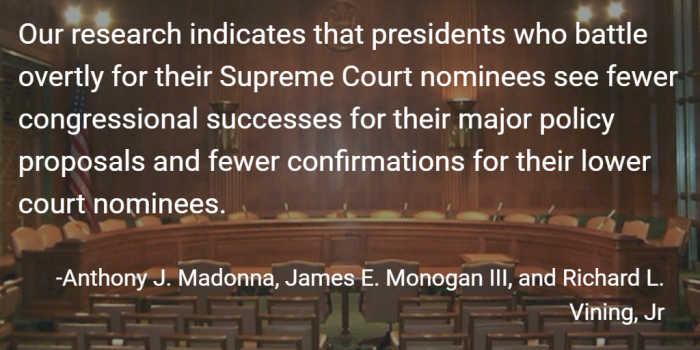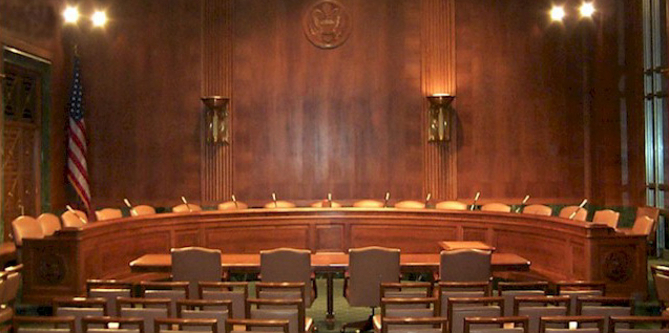

 One of the first tasks for the new president this January – whoever they may be – could be to nominate a new justice to the Supreme Court. But how should the next president go about this? In new research, Anthony J. Madonna, James E. Monogan III, and Richard L. Vining, Jr. find that the more a president supports a particular Supreme Court nominee, the lower the chance that they can get a major new policy initiative through the Senate. If the new president wishes to focus on achieving their policy goals in their first 150 days, they argue, they should compromise by appointing a moderate to the Supreme Court, rather than an ideologue.
One of the first tasks for the new president this January – whoever they may be – could be to nominate a new justice to the Supreme Court. But how should the next president go about this? In new research, Anthony J. Madonna, James E. Monogan III, and Richard L. Vining, Jr. find that the more a president supports a particular Supreme Court nominee, the lower the chance that they can get a major new policy initiative through the Senate. If the new president wishes to focus on achieving their policy goals in their first 150 days, they argue, they should compromise by appointing a moderate to the Supreme Court, rather than an ideologue.
On January 20, 2017, when America’s next president takes the oath of office, nearly a year will have passed since Supreme Court Justice Antonin Scalia died. How to fill this longstanding vacancy has become a fundamental issue in this election. Although Judge Merrick Garland was nominated to fill this vacancy in March 2016, Senate inaction has all but assured that the seat will be vacant when Americans select the next chief executive. How should the next president address this issue?
To understand what makes strategic sense for either Hillary Clinton or Donald Trump upon winning the election, it is important to understand whether a president’s efforts to push a Supreme Court nominee through the Senate are costly in other parts of his or her agenda. Our research indicates that presidents who battle overtly for their Supreme Court nominees see fewer congressional successes for their major policy proposals and fewer confirmations for their lower court nominees. Major policy initiatives in particular are less likely to be enacted at all, and the Senate moves much more slowly on those bills that it does pass. In particular, our study shows that for every 12-sentence speech the president gives in support of a Supreme Court nominee, the odds of Senate passage of a major policy initiative drop by 65 percent in a given month. Thus, the more effort a president has to put into a nominee, the less likely his or her domestic agenda will succeed.
If the Senate Does Not Act in a Lame Duck Session
It is possible that the Senate will confirm Garland to fill the Supreme Court vacancy during a lame duck session between November 8 and January 20, in which case the issue will be moot for the new president. However, let us consider what makes sense if the vacancy is not filled when the new president takes office. What strategies might Clinton or Trump pursue?
The first option is to immediately nominate a strong ideologue to fill the vacancy. If the new president takes this strategy, then the nominee will most likely be confirmed, but after a prolonged fight and at the cost of some major domestic policy initiative the president wants to see. This approach makes sense if the new president has a limited domestic agenda and wants his or her legacy to be defined by the long-term impact of this nominee. Admittedly, the new nominee will be pivotal to the long-term balance of the Court given its current 4-4 partisan split. But at what cost?
When it comes to important domestic policy initiatives, the conventional wisdom is that the president’s first 100 days in office, or “honeymoon period,” are critical to the agenda. Academic research shows that there is some truth to this, though the window is a bit longer at around 150 days. All of this implies that major delays in the Senate due to a contentious Supreme Court nomination would come at the worst possible time for the new president—the time when he or she has a real chance to lead Congress to adopt a signature policy proposal unlike at any other point in the term.

The second option for the new president would be to leave the vacancy open and wait until the end of June 2017 to make a nomination. The advantage of this approach is that it will allow the president to focus on a major domestic policy initiative without the senatorial distraction of fighting over a strong ideologue. Even successful modern confirmation processes tend to last more than two months. This course of action would put the new Supreme Court justice in place by the end of August at the earliest. This delay in nomination would have less impact than one might assume at first blush. After all, in recent terms the Supreme Court’s oral arguments have finished by late April. This suggests a nominee offered early in a president’s term would be unlikely to participate in many cases from the October 2016 term, if any at all. Pursuing such a strategy would mean that the ninth seat on the Supreme Court would have stayed vacant for over a year and half.
A third option is to split the difference and nominate a moderate right away. While this kind of nomination would not produce as much distraction in the Senate, it could still result in troubling delay in the midst of the honeymoon period. This strategy might make the most sense if the president offers a signature policy that is relatively moderate and less controversial, thereby having a moderate impact on the Court and a moderate impact on domestic policy. In an era of partisan polarization, though, even moderate nominees and moderate policy proposals are likely to generate conflict, so paradoxically trying to compromise in both areas might be the riskiest strategy. The bottom line therefore is that the president effectively could face a choice between putting a true ideologue on the Court sooner or passing a major law and letting the Court run with eight members for longer.
Could the Senate Act before Obama’s Term Ends?
Of course, all of this assumes that the next president will face a Supreme Court vacancy on January 20. The odds that will happen greatly depend on who wins the election. If Donald Trump wins, Senate Republicans will continue to delay in order to guarantee that a Trump-nominated conservative will fill the vacancy, thus reinstating the previous balance of 5 conservatives to 4 liberals. President Trump would have to make the decision we have described—either focus on the Supreme Court or domestic policy.
If Hillary Clinton wins, by contrast, confirming Merrick Garland in a lame duck session may look more attractive to Senate Republicans. Under this scenario, it becomes a foregone conclusion that the Supreme Court’s new composition will be 5 liberals to 4 conservatives. However, Garland is one of the most moderate, older liberals that could reasonably be nominated for the position. If President Clinton would like to spend her first 150 days focusing exclusively on her own policy goals and is content to have a moderate liberal fill the vacancy, this compromise could be relatively attractive. Indeed, Senate Democrats have suggested Clinton pursue this option. She could even present the choice to Senate Majority Leader Mitch McConnell, releasing Republican senators from charges of hypocrisy due to their promise that the next president should be charged with selecting Justice Scalia’s successor. This option will be even more attractive to GOP leaders if Democrats make gains in the Senate as anticipated. While Barack Obama would retain the credit for filling the seat, Hillary Clinton would then have more space to make an impact in domestic policy.
This article is based on the paper, ‘Confirmation Wars, Legislative Time, and Collateral Damage The Impact of Supreme Court Nominations on Presidential Success in the U.S. Senate’ in Political Research Quarterly.
Featured image credit: By Satori at en.wikipedia [Public domain], from Wikimedia Commons.
Please read our comments policy before commenting.
Note: This article gives the views of the author, and not the position of USApp– American Politics and Policy, nor of the London School of Economics.
Shortened URL for this post: http://bit.ly/2dRHKXU
______________________
 Anthony J. Madonna – University of Georgia
Anthony J. Madonna – University of Georgia
Anthony J. Madonna is an associate professor at the University of Georgia, where he studies congressional politics.
 James E. Monogan III – University of Georgia
James E. Monogan III – University of Georgia
James E. Monogan III is an assistant professor at the University of Georgia, where he studies political methodology.
_
 Richard L. Vining, Jr – University of Georgia
Richard L. Vining, Jr – University of Georgia
Richard L. Vining, Jr. is an associate professor at the University of Georgia, where he studies judicial politics.






